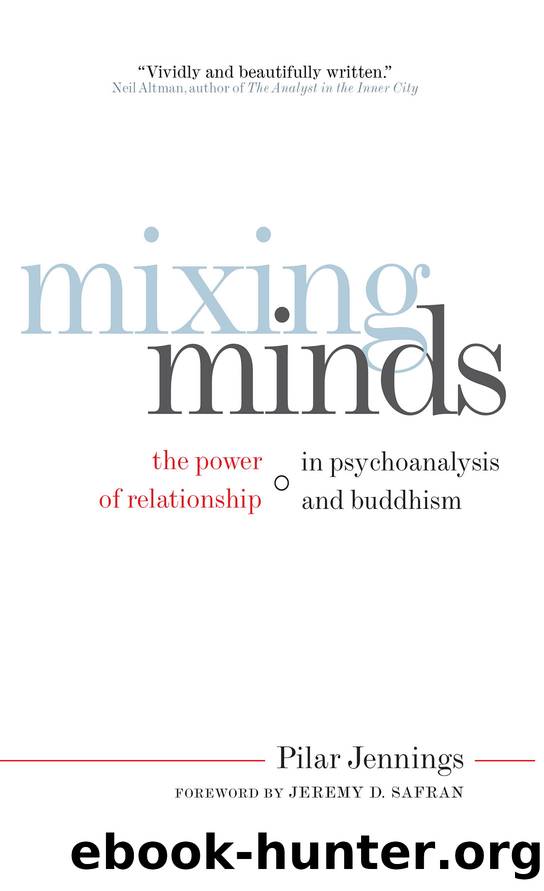Mixing Minds by Pilar Jennings

Author:Pilar Jennings [Pilar Jennings, Jeremy Safran]
Language: eng
Format: epub
Publisher: Wisdom Publications
Published: 2010-12-20T05:00:00+00:00
For Freud, we are by our very nature autonomous beings driven by body-based instincts of hunger, sexuality, life, and death. Concern for others outside our nuclear family units was suspect, an indicator of neurosis (1986). Freud was largely interested in twosâthe interplay of secondary-and primary-process thinking, the fraught relationship between the conscious and unconscious with the warring factions of id, ego, and superego, and the almighty biological father and his woefully rivaling son.
From Freudâs perspective, human suffering had everything to do with our basic instinctual wiring: we longed for total gratification of our id-based urges of sexuality and aggression while simultaneously negotiating the egoâs need for our caretakerâs love and societal protection. This internal, largely unconscious maelstrom of love and hate was at odds with our conscious desire to meet our caretakerâs expectations, the very thing that would ensure our survival within our families and society at large. The key to alleviating this suffering was to bring our unconscious desires and experience into consciousness. Healing traveled along this clear path from primary-process thinkingâthat unconscious and voraciously desirous place withinâto the privileged secondary-process realm where we might consciously acknowledge the truth of our buried internal reality. Consciousness was the Freudian antidote to suffering.
Much to Freudâs dismay, this emphasis on concrete binary systems gave way to Carl Jungâs sea of archetypal imprints that is our collective unconscious. Heavily influenced by Freudâs research and his devoted mentoring, Jung struggled with Freudâs view of the self, with its binarism of conscious and personal unconscious. In his psychiatric practice, he had begun to take note of certain behavioral tendencies that transcended the scope of an individual frame of reference. He did not deny the presence or importance of the personal unconscious, but he found a deeper, more inclusive and potentially life-altering unconscious that operated within every individual psyche. This was our collective unconscious, our psychic inheritance of myriad behavioral patterns and tendencies that existed from the beginning of time. But Jung has remained the exception in the history of psychoanalytic thought. The expansive internal world has left many Western psychoanalytic theorists uncomfortable with the porous boundaries of self and endless others.
For Jung, our most pressing internal psychic mechanism plants us in othernessâboth within and with others (Jung, 1939). He posited an internal gathering function, which he called the Self, that pushes us to integrate our many split-off and lost parts. This integration happens only when we wrestle with the way our particular life experience and struggles intersect with the collective human experience. He proposed that our personal complexes were a royal road to the deepest stratum of our collective unconscious (Jung, 1948).
From the analytic two and the essential conversation between our ego perspective and the Self, that organizing internal mechanism that pushes for wholeness, Jung moved toward a vital third that results when we suffer consciously the opposites within ourselves and between ourselves and others (Ulanov, 2007, p. 163). This third thing might be a symbol or a solution that seems to come to us as a gift from beyond ourselves.
Download
This site does not store any files on its server. We only index and link to content provided by other sites. Please contact the content providers to delete copyright contents if any and email us, we'll remove relevant links or contents immediately.
Rewire Your Anxious Brain by Catherine M. Pittman(17635)
Talking to Strangers by Malcolm Gladwell(11981)
The Art of Thinking Clearly by Rolf Dobelli(8923)
Mindhunter: Inside the FBI's Elite Serial Crime Unit by John E. Douglas & Mark Olshaker(7893)
Becoming Supernatural by Dr. Joe Dispenza(7158)
Change Your Questions, Change Your Life by Marilee Adams(6702)
The Road Less Traveled by M. Scott Peck(6685)
Nudge - Improving Decisions about Health, Wealth, and Happiness by Thaler Sunstein(6684)
The Lost Art of Listening by Michael P. Nichols(6527)
Enlightenment Now: The Case for Reason, Science, Humanism, and Progress by Steven Pinker(6446)
Win Bigly by Scott Adams(6356)
Mastermind: How to Think Like Sherlock Holmes by Maria Konnikova(6293)
The Way of Zen by Alan W. Watts(5843)
Daring Greatly by Brene Brown(5692)
Big Magic: Creative Living Beyond Fear by Elizabeth Gilbert(4779)
Grit by Angela Duckworth(4775)
Men In Love by Nancy Friday(4381)
Flow by Mihaly Csikszentmihalyi(4093)
The Four Tendencies by Gretchen Rubin(4057)
